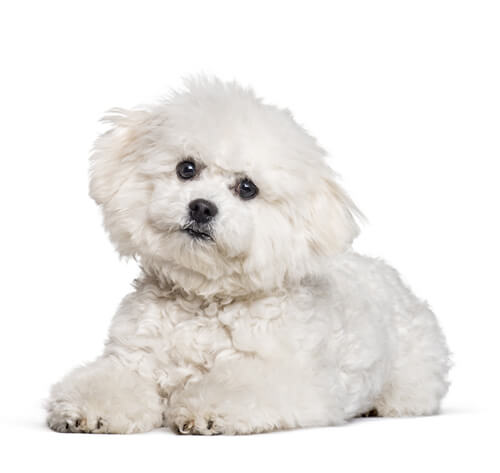
A white powder-puff dog known for his merry temperament, the Bichon Frise originated in the Mediterranean region in the 13th century. Gentle-mannered, sensitive and affectionate, the Bichon is an excellent family companion. This playful breed loves activity and requires regular exercise. Though the Bichon’s fluffy coat does not shed, it requires grooming to prevent mats.
DID YOU KNOW? The Bichon Frise is depicted in a number of works by the noted Spanish painter Francisco de Goya.
ALSO KNOWN AS: Bichon à poil frisé, Bichon Tenerife
The need-to-know
- Dog suitable for non-experienced owners
- Basic training required
- Enjoys gentle walks
- Enjoys walking half an hour a day
- Little toy dog
- Minimum drool
- Requires grooming daily
- Hypoallergenic breed
- Quiet dog
- Guard dog. Barks and alerts
- Great with other pets
- Great family dog
Personality

These lively, happy little dogs adore family life. They love to accompany the family on all outings but can be taught to be left alone occasionally. They socialise well and are fine in the company of other dogs and pets in the household.
History and Origins

Centuries ago, the Bichon Frise dog breed was popular in France and Spain, and the Bichon has been depicted in portraits of the royal families of both countries. Bichon-type dogs were developed on different islands in the Mediterranean, and Tenerife is where the Bichon Frise is thought to have originated. The Bichon of Malta (known as the Maltese today) is a close relative. 14th-century sailors are thought to have taken them over to Europe from Tenerife.
Nutrition and Feeding

Small dogs have a fast metabolism, meaning they burn energy at a high rate, although their small stomachs mean that they must eat little and often. Small-breed foods are specifically designed with appropriate levels of key nutrients and smaller kibble sizes to suit smaller mouths. This also encourages chewing and improves digestion.
Exercise

Bichon Frise dogs will adapt readily to the amount of exercise available from the family circumstances, but half an hour should be considered the minimum daily requirement - along with a chance to exercise their brains!
Other Information

Health and common issues
Bichon Frise dogs are generally very healthy little dogs. However, in common with many other breeds, they can suffer from some hereditary eye problems and kneecaps that may temporarily slip out of place (luxating patellas). They are also prone to developing watery eyes, and predisposed to a type of bladder stone.
Best family dog breeds
While many dogs are traditionally thought of as being good with children , all dogs and children need to be taught to get on with and respect each other, and be safe together. Even so, dogs and young children should never be left alone together and adults should supervise all interactions between them.